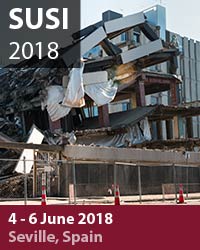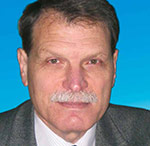SUSI 2018
15th International Conference on Structures under Shock and Impact
![]()
4 - 6 June 2018
Seville, Spain
Overview

The 15th International Conference on Structures under Shock and Impact that took place in Seville, Spain, was organised by the Wessex Institute and the University of Liverpool. The meeting was sponsored by WIT Transactions on the Built Environment, the International Journal of Computational Methods and Experimental Measurements and the International Journal of Safety and Security Engineering.
The conference was part of a well-established series, starting in Cambridge, Massachusetts in 1989 and continuing in a number of locations throughout Europe, the previous meeting in 2016 having taken place in Crete, Greece.
The series originated with Prof Norman Jones from Liverpool University, the foremost authority on Impact Mechanics. After his retirement, Norman became Honorary Chair of the meeting.
Opening of the Conference
The conference was opened by Dr Stavros Syngellakis, a member of Wessex Institute’s Board of Directors. Stavros referred to the importance of the conference series towards fulfilling the objective of the Institute, that is, the transfer of knowledge.
Stavros mentioned that WIT has a series of other activities towards this end, including research and development in its field of expertise, that is, the simulation of engineering and scientific problems using advanced computational methods. WIT is known around the world as the originator of the Boundary Element Method, a technique that it has applied to solve a wide variety of problems. During his talk, Stavros highlighted some case studies relating to the optimal design of corrosion protection systems and assessment of structural integrity against fracture.
In spite of its very specialised knowledge, WIT is aware of the need to collaborate with other centres around the world pursuing different skills, in order to achieve optimum solutions. Because of that, the Institute has participated in many interdisciplinary projects, including some supported by the EU. Further development of WIT’s unique computational tools is continuously required due to the demands of industry, which supports many of these activities.
WIT Press, the publishing arm of the Institute, produces a substantial number of Journals and books every year. The papers in Journals (which include classical scientific papers), as well as the WIT Transactions, are archived in Open Access format in the eLibrary of the Wessex Institute of Technology (https://www.witpress.com/elibrary). This has resulted in a wider distribution of the work presented at WIT conferences.
Stavros concluded his opening address by paying tribute to the founder of Wessex Institute, the late Prof Carlos Brebbia. Prof Brebbia was a gifted academic as well as a great organiser, motivator and communicator. He was an inspiration to everyone working with him. There is a strong commitment among the members of the Institute to preserve his legacy and, in particular, the continued success of this conference series of which he was so proud.
In his opening remarks, Dr Graham Schleyer, the co-chairman of the Conference representing the University of Liverpool emphasised the importance of three concepts, namely community, innovation and realism, to the success of the conference.
The conference provides a sense of community that leads to collaboration. This conference series and many others in association with Wessex was the brainchild of the late Prof Carlos Brebbia who passed away peacefully on Saturday 3rd March 2018. Carlos was both talented and practical and lived life to the full with a spirit of adventure. He will be missed but his legacy is the success of this SUSI conference. SUSI has always provided opportunities for friendly exchange of ideas and collaboration. It continues to attract a good number of younger researchers and PhD candidates who value the opportunity to present their work in a supportive, encouraging environment. We trust this continues into the future for the benefit of the community and the subject.
Most of our research has to do with protection of critical infrastructure against extreme loading (often unintentional or accidental). The cost of large-scale testing is often prohibitive. Therefore there is a strong emphasis on numerical modelling for loading and response predictions and this presents challenges and almost always requires a better understanding of, amongst other things, material selection and design, load definition, constitutive modelling and fracture criteria, computational methods, validation, and scaling issues. There was a good mix of papers this year that addressed most of these important topics.
It is fair to say that the tools and the materials we use nowadays are reasonably well developed although there is always more to discover and much knowledge to transfer to the next generation of engineers and scientists. Consequently, more emphasis should be put on innovative ways of using these materials and protective technologies to further our mission e.g. lightweight, energy-absorbing systems. What works for blast may not work for projectile penetration and vice versa hence there is also a need to develop layered systems. There is much scope to expand this subject into the next decade focusing on innovation and applications.
There is a growing awareness that the expectations of FEA/CFD are unreal. A recent study discussed the pitfalls of the unwary/uninitiated and some of the challenges and issues that arise in practice. This very much applies to our subject and the class of problems we encounter in our work/research. Unfortunately, the FEA method is normally the first tool of choice in most design offices and consultancies. Many aspects of dynamic material properties are poorly understood together with lack of suitable experimental data for validation could lead to inefficient designs or worse potentially unsafe designs.
The trend in engineering education, in general, is to move towards the transferable skills that make graduates more employable. This leaves less space for theory and more reliance on computational methods without fully appreciating the underlying physics of the problem. What can be done to rebalance this trend? It’s not necessary to return to the days when students spent considerable effort in solving problems containing complicated solutions. Rather, more emphasis needs to be given to any errors which might occur in experimental work and to potential errors and limitations in the input and output of numerical solutions and to a deeper interpretation of results.
Keynote Address
Graham then delivered his keynote address entitled “Explosive loading of ductile square plates – a review of analytical methods”, by Graham K Schleyer and Norman Jones.
Invited Presentations
The conference programme was also enhanced by a series of invited presentations:
- “Reworking a simple model for deformable projectile penetration into thick targets”, by Stavros Syngellakis, Wessex Institute, UK.
- “Using a discrete element approach to model impact of rigid projectile on concrete targets”, by Serguei Potapov, Electricite de France, France.
- “Experimental tests on personal safety devices for height fall”, by Juan Carlos Pomares Torres, University of Alicante, Spain.
- “Experimental techniques for high-rate structural component characterization”, by Lauren Stewart, Georgia Institute of Technology, USA
A special session on the theme “Experimental Studies on Force Protection” was organised by Professor Lauren Stewart, a member of the conference’s International Scientific Advisory Committee (ISAC).
Conference Dinner
The ISAC met over dinner to discuss how the meeting could be improved in 2020. The dinner took place in a private room at Restaurant Oriza, offering Andalusian cuisine and an ideal atmosphere for the committee’s deliberations. Among the issues discussed were titles for sessions, WIT’s marketing strategy, attracting contributions from industry, promote the series through contacts. Several new topics were suggested as well as nominations of colleagues to join the Committee. There were also some proposals for suitable venues for the next meeting in two years time. These as well as other possibilities will be carefully examined by the Conference Organising Committee.
The conference dinner was held at "El Patio Sevillano" which is a traditional staged flamenco venue tiled in traditional style, with a gallery for the audience, and with dinner tables on the ground floor periphery. Flamenco dancers and musicians performed almost continuously, during which the delegates enjoyed a dinner comprising dishes of typical Andalucian gastronomy.
The dancers were on a stage at the front, and were accompanied by Spanish classical and folk guitar music, played by two local musicians who performed all their music from memory, and who had the ability to play at amazing speed. The female dancers were wearing the traditional flamenco style of full length colourful and frilled dresses and played castanets loudly as they danced, while stamping their feet to a different beat. There was also traditional singing to accompany the dancers and at one point there was a traditional solo song performed by one of the female dancers. There was also a short excerpt from Bizet's Carmen performed by a trio of singers and dancers and the conclusion to the show was all the dancers performing together on the stage. The quality of the show and the friendly atmosphere helped to strengthen links among the conference delegates.
Closing of the Conference
In his final remarks, Graham thanked the conference coordinator Priscilla Cook for all her hard work in the smooth running of the conference and to the participants for their support. Both the papers and presentations were of a high quality and range that notably impressed the advisory committee and the participants similarly. In particular, one experienced consultant’s testimonial was well received, noting the need to incorporate modelling, experimentation and design into research and project work for a balanced approach.
The Conference was closed by Stavros who thanked the delegates for coming in the name of WIT and, in particular, for contributing to yet another successful conference. He hoped that the conference met all their expectations and that they found time to visit the sites of Seville, a city more than 2,200 years old with a distinct personality and a large and well-preserved historical centre. He looked forward to their participation at the next meeting, which will be reconvened in 2020 in a location and at a date to be announced shortly.
Related Conferences
HPSM/OPTI 2018, 11 - 13 July, 2018
Materials Characterisation 2019, 22 – 24 May 2019
CMEM 2019, 3 – 5 June 2019
ERES 2019, 5 - 7 June 2019
SAFE 2019, 23 – 25 September, 2019



 Wessex Institute
Wessex Institute